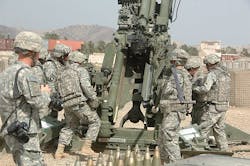Raytheon to provide 757 satellite-guided artillery shells in $51.8 million Army contract
PICATINNY ARSENAL, Ala., 2 July 2014. Artillery munitions experts at the Raytheon Co. Missile Systems segment in Tucson, Ariz., will build 757 M982 Excalibur satellite-guided heavy artillery shells to the U.S. Army under terms of a $51.8 million contract announced late last week.
Officials of the Army Contracting Command at Picatinny Arsenal, N.J., are asking Raytheon to develop the Excalibur smart munitions under the option 5 Excalibur increment lb production option. Excalibur first was fielded in Iraq in 2007 for urban or complex-terrain engagements in which collateral damage must be kept to a minimum.
Excalibur has a ruggedized Global Positioning System (GPS) satellite navigation receiver and uses satellite signals to help guide itself to its intended targets. The 155-millimeter artillery shell can hit targets as far away as 25 miles, or detect and attack moving targets in cities and other complex terrain after being fired at high angles and high altitudes.
The M982 Excalibur precision-guided, extended-range artillery shell is a fire-and-forget smart munition with better accuracy than existing 155-millimeter artillery rounds. These shells are fin-stabilized, and are designed to glide to targets with base bleed technology, as well as with canards located at the front of the munition that create aerodynamic lift.
Related: One shot: smart munitions put weapons on target
Although the M982 is perhaps the longest-range artillery ammunition in the U.S. arsenal, it has the ability to be fired nearly straight up from positions in cities or hilly terrain, engage its precision-guidance system at high altitudes, and detect and attack moving targets -- even individual vehicles -- with an accuracy of better than 65 feet from the desired aim point.
The shells are guided by GPS signals and inertial measurement units, and can be fired from the M109A6 Paladin self-propelled howitzer, as well as from the M198 and M777A2 towed howitzers.
Excalibur artillery shells come in three kinds: high-explosive; smart munitions that detect and attack moving targets; and shells able to identify and attack vehicles individually in cities and other complicated terrain.
Earlier this month Raytheon test-fired a dual-mode GPS- and laser-guided Excalibur S for the first time. Raytheon experts fired the smart munition initialized with a GPS target location, and scored a direct hit on a different, or offset target after being terminally guided with a laser designator, company officials say.
Related: Raytheon to provide 216 satellite-guided heavy artillery shells to attack moving targets
The new variant incorporates a laser spot tracker into the combat-Excalibur Ib projectile. "The performance of Excalibur S is very impressive and I am extremely encouraged by Raytheon's commitment to the next generation of Excalibur," says Army Lt. Col. Josh Walsh, the Army's Excalibur product manager.
This test validated the laser spot tracker's ability to survive the forces of firing from a 155-millimeter howitzer and then hand off from the GPS to guide to a laser spot on the designated target.
The laser spot tracker will enable the munition to attack moving targets, engage enemy artillery that have moved after firing, or change the impact point to avoid casualties and collateral damage.
"A laser-guided variant of Excalibur gives the warfighter a precision weapon that accommodates target location errors, allows continued target attack when GPS is degraded or denied, and hit targets on the move at extended ranges," says Michelle Lohmeier, vice president of Raytheon Missile Systems' Land Warfare Systems product line.
Related: The future of precision-guided munitions
Excalibur S also paves the way for Excalibur Ib customers to upgrade their Excalibur Ib guidance and navigation units with GPS and laser spot tracker capability, Raytheon officials say.
The same capability can also be built into the 5-inch Excalibur naval variant, Excalibur N5, that Raytheon has in development. The Excalibur N5, a five-inch naval variant, can provide surface warships with extended-range precision surface fire.
The Army also is developing a GPS-guided 120-millimeter mortar round called the Roll Control Guided Mortar (RCGM) together with the General Dynamics Corp. Ordnance and Tactical Systems segment in St. Petersburg, Fla.
On the contract announced Friday, Raytheon will do the work at Anniston, Ala.; Tucson, Ariz.; Phoenix; East Camden, Ark.; Chino, Calif.; Corona, Calif.; Healdsburg, Calif.; Inglewood, Calif.; Santa Ana, Calif.; Valencia, Calif.; Woodridge, Ill.; Cedar Rapids, Iowa; Cincinnati; Lowell, Mass.; Minneapolis; Joplin, Mo.; Farmington, N.M.; McAlester, Okla.; McKinney, Texas; Kariskoga, Sweden; and locations in the United Kingdom, and should be finished by February 2016.
For more information contact Raytheon Missiles Systems online at www.raytheon.com, or the Army Contracting Command at Picatinny Arsenal at www.pica.army.mil.

John Keller | Editor
John Keller is editor-in-chief of Military & Aerospace Electronics magazine, which provides extensive coverage and analysis of enabling electronic and optoelectronic technologies in military, space, and commercial aviation applications. A member of the Military & Aerospace Electronics staff since the magazine's founding in 1989, Mr. Keller took over as chief editor in 1995.

